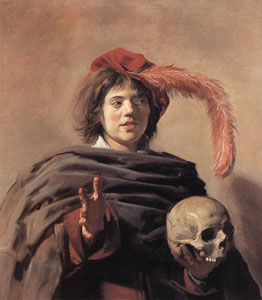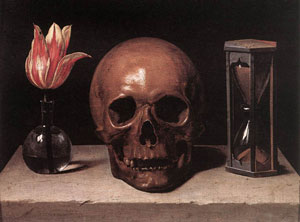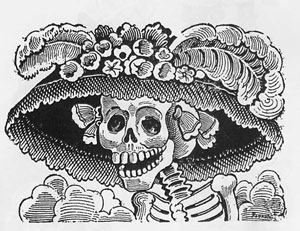
Home
|
Gualala Arts
Promoting public interest and participation in the arts since 1961.
Archive of past events: 2004 through 2014
Memento Mori:
An Exhibition of Contemporary Art
Exploring Death and the Ephemeral
Curator: Sharon Nickodem
Opening Reception: Friday, November 2 at 5:00 p.m.
Exhibit remains through November 18, 2012
Gualala Arts Center
Memento mori is a Latin phrase translated as "Remember you must die" (and the origin of the English word memento, which appeared as memento mori, "remembrance of death"). It describes a genre of artistic work which varies widely, but which all share the same purpose: to remind people of their own mortality. The phrase has a tradition in art that dates back to antiquity. This subject need not be all doom and gloom, but is open to comic interpretation, the ecstasy and joy of transformation and the beauty of our love for the departed.
For this exhibit, artists are encouraged to explore the concepts of death and passages, using all forms of media, 2-D and 3-D. This exhibit is not juried and is open to all artists. The work submitted must be no more than 2 years old and may not have been exhibited publicly on the Mendonoma coast at any time in the past.
To see more detailed rules, you may download the registration form. The completed registration form is due to the Gualala Arts office by October 20, 2012.
Examples of Memento mori art through-out history,
according to Wikipedia's article on
Memento mori:
|

Frans Hals, Youth with a Skull
|
...[Memento mori] thought came into its own with Christianity, whose strong emphasis on Divine Judgment, Heaven, Hell, and the salvation of the soul brought death to the forefront of consciousness. Most memento mori [artworks] are products of Christian art, although there are equivalents in Buddhist art. In the Christian context, the memento mori acquires a moralizing purpose quite opposed to the Nunc est bibendum (now it the time to drink) theme of Classical antiquity. To the Christian, the prospect of death serves to emphasize the emptiness and fleetingness of earthly pleasures, luxuries, and achievements, and thus also as an invitation to focus one's thoughts on the prospect of the afterlife...
The most obvious places to look for memento mori meditations are in funeral art and architecture. Perhaps the most striking to contemporary minds is the transi, or cadaver tomb, a tomb which depicts the decayed corpse of the deceased. This became a fashion in the tombs of the wealthy in the fifteenth century, and surviving examples still create a stark reminder of the vanity of earthly riches. The famous danse macabre, with its dancing depiction of the Grim Reaper carrying off rich and poor alike, is another well known example of the memento mori theme. This and similar depictions of Death decorated many European churches. Later, Puritan tomb stones in the colonial United States frequently depicted winged skulls, skeletons, or angels snuffing out candles. These are among the numerous themes associated with skull imagery...

Philippe de Champaigne's Vanitas (c. 1671)
is reduced to three essentials: Life, Death, and Time
|
A version of the theme in the artistic genre of still life is more often referred to as a vanitas, Latin for "vanity." These include symbols of mortality, whether obvious ones like skulls, or more subtle ones, like a flower losing its petals. See the themes associated with the image of the skull, [such as Philippe de Champaigne's Vanitas, where the theme is reduced to three essentials: Life, Death, and Time, at left.]
After the invention of photography, many people had photographs taken of recently dead family members; given the technical limitations of daguerreotype photography, this was one way to get the portrait subject to sit still.
Memento mori was also an important literary theme. Well known literary meditations on death in English prose include Sir Thomas Browne's Hydriotaphia, Urn Burial and Jeremy Taylor's Holy Living and Holy Dying. These works were part of a Jacobean cult of melancholia that marked the end of the Elizabethan era. In the late eighteenth century, literary elegies were a common genre; Thomas Gray's Elegy Written in a Country Churchyard and Edward Young's Night Thoughts were typical members of the genre.

Posada's 1913 La Calavera Catrina
|
Apart from the genre of requiem and funeral music there is also a rich tradition of memento mori in the Early Music of Europe. Especially those facing the ever present death during the recurring bubonic plague pandemics from the 1340s onward tried to toughen themselves by anticipating the inevitable in chants, from the simple Geisslerlieder of the Flagellant movement to the more refined cloistral or courtly songs. The lyrics often looked at life as a necessary and god-given vale of tears with death as a ransom and reminded people to lead sinless lives to stand a chance at Judgment Day...
Much memento mori art is associated with the Mexican festival, Day of the Dead, including even skull-shaped candies, and bread loaves adorned with bread "bones." It was also famously expressed in the works of the Mexican engraver José Guadalupe Posada, in which various walks of life are depicted as skeletons...
|
|
Memento mori. (2011, July 12). In Wikipedia, The Free Encyclopedia.
http://en.wikipedia.org/w/index.php?title=Memento_mori&oldid=439102643
This text is available under the
Creative Commons Attribution-ShareAlike License.
|
In modern times, memento mori art continues to encompass all the nostalgic concepts and symbols used in the past, but today's art also explores these ideas using contemporary symbols and more irreverent expressions.

Rex Mus by Doric Jemison-Ball
|
The Gualala Arts Center, located at 46501 Old State Highway in Gualala, CA,
is open weekdays 9:00 a.m. to 4:00 p.m., and weekends from noon to 4:00 p.m.
Please call (707) 884-1138 for more information, or email
info@gualalaarts.org.
Serving the coastal communities of northern Sonoma & southern Mendocino Counties.
|
|




